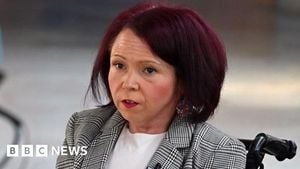Warnings of a speculative bubble in artificial intelligence have been echoing through tech circles and Wall Street for months, drawing parallels to the infamous dot-com crash of the late 1990s. As AI companies pour hundreds of billions of dollars into advanced chips, sprawling data centers, and ever-more ambitious projects, the debate over whether the sector is overheating—or merely gearing up for a new era—has reached a fever pitch. At the heart of the discussion stands Nvidia, now the world’s most valuable company, and a vivid symbol of AI’s explosive growth and the anxieties that come with it.
On November 23, 2025, Michael Burry, the investor made famous by his prescient bets against the 2008 housing market (and immortalized in The Big Short), published his first Substack post, “The Cardinal Sign of a Bubble: Supply-Side Gluttony.” Burry drew a direct line between today’s AI boom and the dot-com bubble, singling out Nvidia as the “Cisco” of the current era. According to Burry, “Folly makes money. Creative destruction and manic folly are exactly why the U.S. is the center of innovation in the world. Companies are allowed to innovate themselves to death. And ever more spring up to do the same. Sometimes the new company is the same company on a pivot.”
Burry’s analogy is pointed: Cisco’s stock soared 3,800% between 1995 and 2000, briefly making it the world’s most valuable company at $560 billion, only to see its value collapse by more than 80% as the dot-com bubble burst. Today, Nvidia’s market valuation sits at a staggering $5 trillion, and Burry warns that history could be repeating itself. “And once again there is a Cisco at the center of it all, with the picks and shovels for all and the expansive vision to go with it,” Burry wrote. “Its name is Nvidia.”
Burry’s skepticism is more than just talk. Earlier this month, his hedge fund, Scion Asset Management, snapped up over $1 billion in put options—essentially bets against Nvidia and Palantir. Not long after, Burry deregistered Scion, stepping away from managing outside money. His critique centers on Nvidia’s ability to sustain demand for its chips and the actual longevity of its hardware.
The AI sector’s investment frenzy is not limited to hardware. Tech companies are racing to build infrastructure for AI tools like ChatGPT, Gemini, and Claude, with total spending projected to reach into the trillions. Financing comes from venture capital, debt, and increasingly, from unconventional circular financing arrangements that have drawn scrutiny on Wall Street. As Fortune reported, these arrangements can create a “giant blob of AI companies passing the same billions of dollars back and forth.” Nvidia, for example, pledged $100 million to OpenAI in September and announced a $10 billion investment in Anthropic in November. Anthropic, in turn, is investing $30 billion to scale its Claude AI model on Microsoft’s Nvidia-powered Azure cloud platform.
Lisa Shalett, chief investment officer at Morgan Stanley Wealth Management, added her voice to the chorus of concern in September, warning of a potential “Cisco moment” for the AI sector within the next two years. She pointed to the increasingly interwoven nature of the industry, with companies investing in one another and creating a circular flow of capital that could prove unsustainable.
Despite these warnings, Nvidia’s leadership has pushed back forcefully. The company’s latest quarterly earnings, released in mid-November, showed a 62% surge in revenue—numbers that would make even the most hardened skeptic take notice. Chief financial officer Colette Kress defended the longevity and efficiency of Nvidia’s chips, crediting the company’s CUDA software system for extending hardware life. CEO Jensen Huang, in a November interview on Fox Business’s The Claman Countdown, dismissed bubble fears: “We reinvented computing for the first time in 60, 70 years. And so all of the computers that have been installed around the world [are] being modernized to accelerated computing and video GPUs and to artificial intelligence. And so this build-out is going to last us many years to come.”
Huang echoed these sentiments in a separate interview with Bloomberg TV, saying, “I don’t believe we’re in an AI bubble. We’re going through a natural transition from an old computing model based on general purpose computing to accelerated computing.” He argued that AI’s capabilities are now so advanced that the intelligence generated is “worth paying for.”
The debate over an AI bubble is anything but settled. OpenAI CEO Sam Altman, whose company has been at the epicenter of the AI boom, publicly stated in August, “Are we in a phase where investors as a whole are overexcited about AI? My opinion is yes. Is AI the most important thing to happen in a very long time? My opinion is also yes.” Microsoft cofounder Bill Gates, speaking to CNBC in late October, agreed that there is a bubble—but not one as extreme as the tulip mania of centuries past. “Absolutely, there are a ton of these investments that will be dead ends,” Gates said. Yet he called AI “the biggest technical thing ever in my lifetime.”
Other tech titans have weighed in with their own perspectives. Mark Cuban, who famously sold Broadcast.com before the dot-com crash, doesn’t see the same signs this time around. “We’re not seeing funky AI companies just go public,” Cuban told Lex Fridman in 2024. “If all of a sudden we see a rush of companies who are skins on other people’s models or just creating models to create models that are going public, then yeah, that’s probably the start of a bubble.”
Meta CEO Mark Zuckerberg, for his part, said in September that an AI crash could be avoided if companies keep making real advancements: “If the models keep on growing in capability year-over-year and demand keeps growing, then maybe there is no collapse.” Google CEO Sundar Pichai, speaking to the BBC in November, acknowledged “elements of irrationality” in the AI boom and warned that no company would be immune if a crash occurs.
Amazon founder Jeff Bezos described the moment as an “industrial bubble,” distinguishing it from more destructive speculative bubbles. “The good ideas and the bad ideas. And investors have a hard time in the middle of this excitement, distinguishing between the good ideas and the bad ideas,” he said in October. “And that’s also probably happening today.” Yet Bezos emphasized that AI is real and will change society, and that “industrial” bubbles can ultimately be beneficial by funding transformative inventions.
JPMorgan Vice Chairman Daniel Pinto predicted a market correction in November, saying, “In order to justify these valuations, you are considering a level of productivity that, it will happen, but it may not happen as fast as the market is pricing now.” OpenAI chairman Bret Taylor echoed the duality, telling The Verge in September, “I think it is both true that AI will transform the economy, and I think it will, like the internet, create huge amounts of economic value in the future. I think we’re also in a bubble, and a lot of people will lose a lot of money.”
As the debate rages, the AI boom shows no sign of slowing. Billions continue to pour into infrastructure, research, and new applications, even as the specter of a bubble looms large. Whether this era ends in a spectacular crash or ushers in a new technological renaissance remains to be seen. For now, the only certainty is that the stakes—and the scrutiny—have never been higher.





